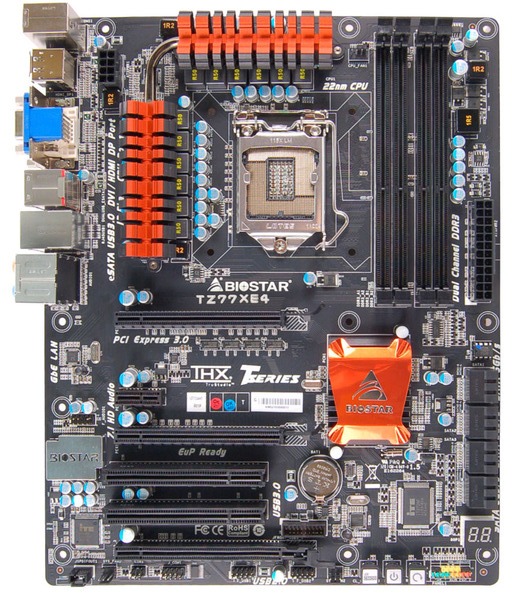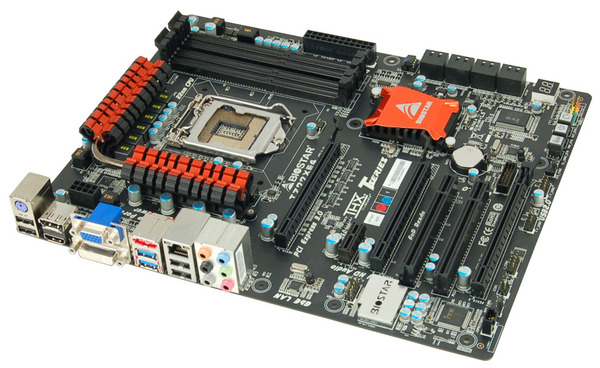Intel Z77 Panther Point Chipset and Motherboard Preview – ASRock, ASUS, Gigabyte, MSI, ECS and Biostar
by Ian Cutress on April 8, 2012 12:00 AM EST- Posted in
- Motherboards
- Intel
- Biostar
- MSI
- Gigabyte
- ASRock
- Asus
- Ivy Bridge
- ECS
- Z77
Biostar TZ77XE4—Visual Inspection
With memories of Biostar fresh in my mind from the 990FX roundup, I have another chance to tackle a motherboard from them. This one comes in at more of a premium than the other—at an MSRP of $169 it is not the cheapest board this time. However, it does seem to have learned some lessons with the PCIe layout at least, but in terms of features we are perhaps a bit lacking.
Biostar have characteristically been black and orange, and we see it here again on their top Z77 model, the TZ77XE4. Power delivery is essentially a 10+2 (CPU/iGPU) system with large brightly colored heatsinks to remove heat, both connected via a heatpipe. These heatsinks are set a little away from the Intel designated socket area, though the memory banks are right up against the boundary—with only two sticks of memory in the board there will be enough room for most of the beefiest air coolers.
In terms of fan headers, Biostar have unfortunately put much effort in here, with only three to play with—a 4-pin CPU fan header to the top right of the socket, and two 3-pin at the south end of the board. Anyone requiring headers for fans will have to resort to providing their own fan control.

Along the right hand side, apart from the 24-pin power connector, we have a series of eight SATA ports—two SATA 6 Gbps from the PCH, four SATA 3 Gbps also from the PCH, and another two SATA 6 Gbps from an ASMedia controller. These are unfortunately not color coded, meaning users will have to double check every time that the SATA cable is going into the port as intended. Below these, we have a two-digit debug display for error reporting.
The chipset heatsink sports the bright orange Biostar color, but is rather small which could lead to it being warm to the touch. On the south side of the board, we are not exactly bursting with headers—aside from the fans, we have front panel headers, a pair of USB 2.0 headers, and power/reset/clear CMOS buttons. These buttons are all similar and next to each other, so I can just see myself accidentally pressing the wrong one from time to time. It is also important to note the location of a USB 3.0 header, just above the third full-length PCIe slot. This is a rather awkward place, and cements its use primarily for rear facing adaptors (as long as there is nothing in the PCI slot beside it).

The PCIe layout is better than previous iterations, featuring an x16 (x8 in dual-GPU), x1, x8, PCI, PCI and Gen 2.0 x4. This leaves a space between GPUs, and a spare x1, PCI and x4 when dual GPUs are being used. Note we do not have a molex connector here, suggesting that Biostar are happy with the power delivery when the PCIe slots are in use.

For back panel functionality, we have a PS2 keyboard port, two USB 2.0 ports (black), DisplayPort, HDMI, D-Sub, DVI-I, eSATA, two USB 3.0 (blue), gigabit Ethernet, two more USB 2.0 (black), and audio jacks. I should stress that even though there is a DVI-I on the back panel, it does not accept analog signals by adaptor.
Board Features
| Biostar TZ77XE4 | |
| Size | ATX |
| CPU Interface | LGA-1155 |
| Chipset | Intel Z77 |
| Power Delivery | 10 + 2 + 1 + 2 (CPU/GPU/VCCIO/Memory) |
| Memory Slots |
Four DDR3 DIMM slots supporting up to 32 GB Up to Dual Channel, 1066-2600 MHz |
| Video Outputs | DisplayPort, HDMI, DVI-D, D-Sub |
| Onboard LAN | Realtek 8111E |
| Onboard Audio | Realtek ALC898 |
| Expansion Slots |
2 x PCIe x16 Gen3 (x16, x8/8) 1 x PCIe x16 Gen2 (x4) 1 x PCIe x1 Gen2 2 x PCI |
| Onboard SATA/RAID |
2 x SATA 6 Gbps (PCH), Support for RAID 0, 1, 5, 10 4 x SATA 3 Gbps (PCH), Support for RAID 0, 1, 5, 10 2 x SATA 6 Gbps (ASMedia Controller) 1 x eSATA 3 Gbps |
| USB |
4 USB 3.0 ports (2 back panel, 2 from headers) 8 USB 2.0 ports (4 back panel, 4 from headers) |
| Onboard |
4 x SATA 6 Gbps 4 x SATA 3 Gbps 1 x USB 3.0 Header 2 x USB 2.0 Header 3 x Fan Headers 1 x CIR Header 1 x SPDIF Output Header 1 x Front Panel Audio Header |
| Power Connectors |
1 x 24-pin ATX connector 1 x 8-pin 12V connector |
| Fan Headers |
1 x CPU Fan Header (4-pin) 2 x SYS Fan Header (3-pin) |
| IO Panel |
1 x PS/2 Keyboard Port 1 x eSATA 2 x USB 3.0 4 x USB 2.0 1 x DisplayPort 1 x HDMI 1 x DVI-D 1 x D-Sub 1 x Gigabit Ethernet Audio Jacks |
| Warranty Period | 3 years from date of sale |
| Product Page | Link |
Aside from the extra SATA controller, PCI slots, Power/Reset buttons and the use of all four display outputs, there's nothing much 'extra' that Biostar have put on the board which isn't already in the default chipset. This could perhaps be their downfall when it comes to conclusions after testing.










145 Comments
View All Comments
MrSpadge - Sunday, April 8, 2012 - link
"multiples of 15 Hz (15, 30, 35, 60, 75)" on page 2Ryan Smith - Sunday, April 8, 2012 - link
Got it. Thanks.MrSpadge - Sunday, April 8, 2012 - link
How does it work together with nVidias adaptive VSync, which debuted with the GTX680? And which, IMO, looked quite promising (lowering average power consumption a lot while gaming).Ryan Smith - Sunday, April 8, 2012 - link
You wouldn't use MVP with Adaptive V-Sync. It only makes sense to use MVP by itself.Thaine - Thursday, August 16, 2012 - link
"Predicting which frames (or rendering tasks) will never be shown and taking them out of the pipeline so the GPU can work on what is needed"Along the lines of power consumption (and the ever-important side effect, heat), I would be very interested in seeing an article on MVP vs power consumption/heat on a power-hungry dGPU (ala GTX 480).
primonatron - Sunday, April 8, 2012 - link
Not sure why most of these boards bother including the non-Intel USB 3.0 controllers any more.Not many people have several USB 3.0 devices, so they could be saving costs. Or instead bringing back some of the things the article mention were taken away - like DVI on an ASUS board.
GreenEnergy - Sunday, April 8, 2012 - link
I think board makers are getting desperate for ways to add value.Less and less components to change and diversify with.
And its not getting better in the future. Haswell on LGA1150 basicly removes the entire VRM part on the motherboard. No more 32 phases or whatever.
A 50$ board performs identical to a 200$ board if you dont overclock. Actually the 50$ board might be more reliable (less components to fail) and more power efficient.
Xale - Sunday, April 8, 2012 - link
50 dollar boards are probably going to at least boot faster. The driver load and POST times with many 3rd party controllers, SATA especially, is atrocious. Seen some boards that take nearly 3x longer if the external controllers aren't disabled.Metaluna - Sunday, April 8, 2012 - link
Mostly marketing I would guess. Intel only supports 4 3.0 ports, so if you add another chip you now have a checklist item to justify the premium price of your motherboard and possibly differentiate it from lower-end versions in the same product line.Second, ASUS owns ASMedia, who makes a lot of the (mediocre, IMHO) USB 3 and Bluetooth controllers on their boards, so there's probably an incentive to use them in their own products to help prop up their production volumes.
Third, a lot of the third party controllers have special modes to support things like high-current charging for iPads or charging when the computer is turned off. Does anyone know if it's possible to add these features to Intel-based ports? If not, that would be an incentive to include a secondary chip.
GreenEnergy - Sunday, April 8, 2012 - link
I saw the DH77DF im looking at myself got high current recharge. So that doesnt seem to be related to the controller at all.